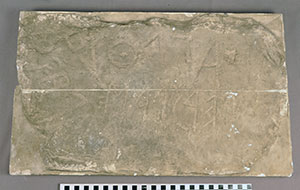Plaster Cast: Gravestone Inscription
1900.11.0099
Detailed Images
Basic Information
| Artifact Identification | Plaster Cast: Gravestone Inscription (1900.11.0099) |
|---|---|
| Classification/ Nomenclature |
|
| Artist/Maker | Berlin Museum. Gipsformerei. Previously attributed to Emile Gillieron & Fils. |
| Geographic Location | |
| Period | Archaic |
| Date | 650-550 BCE |
| Culture | Ancient Greek |
| Location | Not on Exhibit |
Physical Analysis
| Dimension 1 (Length) | 57.7 cm |
|---|---|
| Dimension 2 (Width) | 35.2 cm |
| Dimension 3 (Depth) | 5.4 cm |
| Weight | 5025 g |
| Measuring Remarks | Under Review |
| Materials | Plaster, Metal |
| Manufacturing Processes | Cast |
Research Remarks
| Description | Plaster cast of the left side of a large flat slab of dark grey volcanic stone, with at least nine, possibly ten names inscribed in total on its four sides in the early Theran alphabet: three words at the middle of the upper face, with two more crowded near the edges at left and bottom; five more are inscribed around each of the three low vertical sides of the slab. The text occupying the left side of the slab is (IG XII 3.762b). The letters are between ?? and ?? cm. high. The letters of the epichoric Theran alphabet are transliterated as follows: |
|---|---|
| Published Description | N/A |
| Bibliography | Guarducci, M. L'epigrafia greca dalle origini al tardo impreo. Rome, 1987: Instituto poligrafico e Zecca dello stato: Libreria dello Stato, 80. |
Artifact History
| Credit Line/Dedication | Classical Museum Purchase |
|---|---|
| Reproduction | Yes, Original displayed in the Athens Epigraphical Museum. Reproduction probably made by the staff of the Athens National Archaeological Museum, perhaps Emile Gillieron & Fils, Athens. The casts of the front and right side of this slab are Spurlock artifacts 1900.11.0103 and 1900.11.0102 respectively. |
Contact
All information about our collection is constantly reviewed and updated. Please contact Dery Martínez-Bonilla, Registrar, if there is any information you are looking for that isn't currently online.
